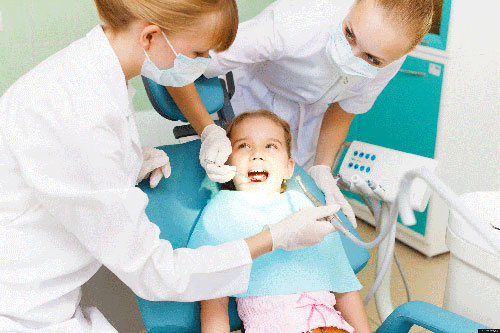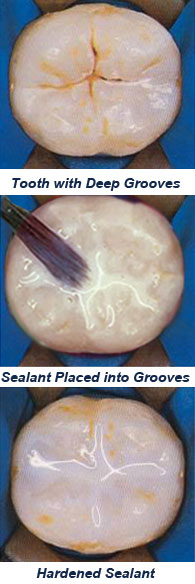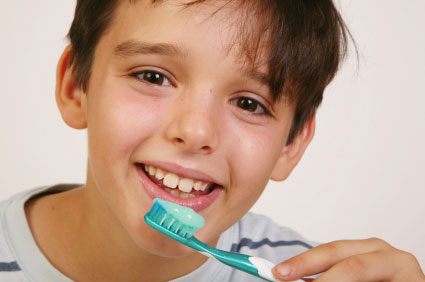As our daily lives seem busier and faster-paced than ever, one phrase comes to mind: The future is now. Children’s oral healthcare habits today will have an impact on their health as an adult. The good news is that preventive dental care has dramatically improved the oral health of many American children. It is now possible for children to reach adulthood without ever experiencing tooth decay. However, tooth decay remains a serious public health problem. It is the most common chronic childhood disease that will not resolve without treatment. It is five times more common than asthma.
First Dental Visit
As your child’s first tooth erupts, consult one of our dentists regarding scheduling a first dental visit. It is advantageous for the first dental visit to occur within six months after the first tooth erupts, but not later than the first birthday. Treat the first dental visit as you would a baby checkup with the child’s physician. During the first visit, our dentist: (1) review the medical and dental histories; (2) complete a thorough oral examination to assess growth and development, oral hygiene, injuries, cavities and/or other problems; (3) clean the teeth as indicated and provide suggestions about daily care; (4) evaluate and optimize your child’s fluoride exposure because too much or too little can lead to problems; (5) review feeding practices and provide dietary counseling; (6) assess your child’s risk of developing tooth decay; (7) provide information regarding oral development, teething, pacifier or finger/thumb sucking habits and injury prevention; and (8) plan for any needed treatment or the next checkup. Our dentist also will answer any questions you may have.

Dental Sealants
A sealant is a material that is applied to the chewing surfaces of back teeth (premolars and molars), and sometimes to deep pits and grooves of front teeth, where decay occurs most often. The sealant acts as a barrier, protecting the decay-prone areas of the teeth from accumulating plaque that results in acid attacks and tooth decay. Pits and fissures are depressions and grooves in the surfaces of the teeth that often are difficult to keep clean because toothbrush bristles cannot reach into them. The sealant forms a thin covering that keeps out plaque and food and decreases the risk of tooth decay. Sealing a tooth is fast and there is virtually no discomfort. The dentist conditions the chewing surfaces to help the sealant adhere to the tooth and then applies the sealant to the tooth enamel. As long as the sealant remains intact, the tooth surface will be protected from decay. Sealants hold up well under the force of normal chewing and usually last several years before a reapplication is needed. Both primary and permanent teeth can benefit from sealants. Ask your dentist if sealants will help your child.
Dental Visits
Regular dental visits are crucial to maintaining a healthy smile. During the dental visit, the dentist examines the child’s mouth for tooth decay and growth or development conditions that may pose a problem in the future. How often should a child see a dentist? Children’s needs differ, and your dentist is best able to suggest a schedule of visits for your child. The frequency of dental visits will partly depend on your child’s eating habits; how clean the teeth are kept; past treatment needs; whether your child drinks fluoridated water; and other factors that can affect your child’s susceptibility to dental diseases. Professional dental services, such as regular cleanings, fluoride treatments and the application of sealants that prevent tooth decay, can save money and reduce the need for further dental treatment. Set a good example for your child by brushing your own teeth twice a day, flossing daily, and visiting the dentist regularly.

Malocclusion
Malocclusion, or bad bite, is a condition in which the teeth are crowded, crooked or out of alignment, or the jaws don’t meet properly. This condition may become particularly noticeable between the ages of six and 12, when the permanent teeth are erupting. This “bad bite” may be inherited or result from events in the child’s development. Every child should receive an orthodontic evaluation by age seven. Early examination and treatment may help prevent or reduce the severity of malocclusions in the permanent teeth. An early evaluation allows the dentist/orthodontist to determine when any recommended treatment should begin. The developing occlusion should be monitored throughout eruption. Starting treatment or preventive care at the best time may reduce the overall treatment time and result in the best outcome. Dentists/orthodontists try to prevent the development of malocclusions, when possible. Some preventive orthodontic treatment may be started when the primary teeth are still in place. Often effective preventive treatment is done during a child’s growth period. Different types of orthodontic appliances, including some that are removable, are used to prevent and treat malocclusions. Orthodontic treatment may be divided into distinct stages or it may be continuous over a period of many months or more. The starting age, the duration of treatment, the type of appliances used, the outcome of the treatment, and the cost of treatment depend upon the nature and the severity of the malocclusion being treated. In most cases, the cooperation of the patient – practicing good oral hygiene and maintaining scheduled appointments with the dentist – are major factors in the success of orthodontic treatment.

Mouth Protectors
When a child participates in sporting and recreational activities, injuries can occur. Mouth protectors, also called mouth guards, are an important piece of protective face gear. You’ve probably seen mouth protectors used in contact sports, such as hockey, football or boxing. Coaches and team members know that mouth protectors cushion blows that would otherwise cause broken teeth, injuries to the lips and face and sometimes even jaw fractures. Non-contact sports such as soccer, volleyball, and gymnastics and leisure activities such as bicycling, roller skating and skateboarding also place a child at risk for dental injuries. If your child participates in such pastimes, ask your dentist about custom-fitted and store purchased mouth protectors.

